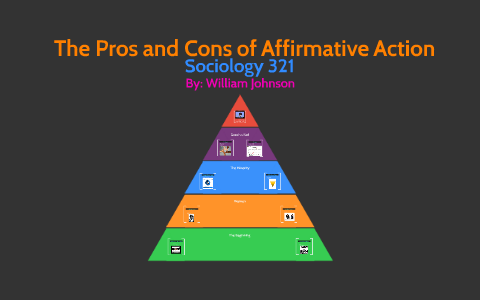Debating Affirmative Action: Benefits and Drawbacks

Affirmative action is a complex and highly debated topic that has sparked numerous discussions and divided opinions. This policy, aimed at promoting equal opportunities and addressing historical injustices, has both advocates and critics. In this comprehensive exploration, we delve into the benefits and drawbacks of affirmative action, analyzing its impact on various aspects of society and offering a balanced perspective.
Understanding Affirmative Action

Affirmative action is a set of policies and initiatives designed to counteract discrimination and promote equal access to opportunities in education, employment, and other sectors. It seeks to rectify past and present inequalities by giving preferential treatment to underrepresented groups, such as racial and ethnic minorities, women, and individuals with disabilities. The goal is to create a more inclusive and equitable society by addressing systemic barriers and promoting diversity.
The Benefits of Affirmative Action

Promoting Diversity and Inclusion
One of the most significant benefits of affirmative action is its ability to foster diversity in various institutions and organizations. By actively encouraging the inclusion of underrepresented groups, affirmative action brings diverse perspectives, experiences, and talents to the forefront. This diversity enhances creativity, innovation, and problem-solving capabilities, leading to more robust and dynamic environments.
For example, in higher education, affirmative action policies have increased the representation of students from diverse racial and ethnic backgrounds. These students bring unique cultural insights and experiences, enriching the learning environment and fostering a more tolerant and understanding student body. Additionally, diverse student bodies often lead to better academic outcomes and a more comprehensive educational experience.
Addressing Historical Inequalities
Affirmative action serves as a mechanism to address historical injustices and systemic discrimination. Throughout history, certain groups have faced systemic barriers and discrimination, limiting their access to opportunities and resources. Affirmative action aims to rectify these imbalances by providing targeted support and resources to historically marginalized communities.
In the context of employment, affirmative action policies have helped bridge the wage gap between different racial and gender groups. By implementing hiring practices that prioritize diversity, organizations can reduce discrimination and ensure that talented individuals from all backgrounds have equal chances of securing lucrative positions. This, in turn, contributes to a more just and fair society.
Empowering Underrepresented Groups
Affirmative action empowers individuals from underrepresented groups by providing them with opportunities they may not have otherwise had access to. These opportunities can range from scholarships and financial aid to preferential hiring practices and mentorship programs. By leveling the playing field, affirmative action allows individuals to pursue their aspirations and achieve success, regardless of their background.
Take the case of women in leadership positions. Affirmative action initiatives have played a crucial role in increasing the number of women in senior management roles and corporate boards. By actively promoting and supporting women's leadership, these policies have shattered glass ceilings and inspired a new generation of female leaders, creating a more balanced and inclusive corporate landscape.
The Drawbacks of Affirmative Action
Reverse Discrimination Concerns
One of the most prominent criticisms of affirmative action is the potential for reverse discrimination. Critics argue that by giving preferential treatment to certain groups, affirmative action discriminates against individuals who are not part of those groups. This argument suggests that affirmative action may disadvantage qualified individuals who do not belong to underrepresented categories.
For instance, in college admissions, some argue that affirmative action policies may lead to the rejection of highly qualified candidates from majority groups in favor of less qualified applicants from underrepresented minorities. While this concern is valid, it is essential to note that affirmative action policies are designed to consider a holistic evaluation of applicants, taking into account various factors beyond just academic achievements.
Ineffectiveness in Addressing Root Causes
Another critique of affirmative action is its perceived ineffectiveness in addressing the root causes of inequality. Critics argue that while affirmative action may provide temporary solutions, it fails to tackle the systemic issues that perpetuate discrimination and inequality. They suggest that addressing these underlying causes, such as poverty, education disparities, and societal biases, should be the primary focus.
For example, in the realm of healthcare, affirmative action policies may aim to increase the representation of minority healthcare professionals. While this is a noble goal, it does not address the deeper issues of healthcare access and disparities in healthcare outcomes among different racial and ethnic groups. To truly make a lasting impact, efforts should be directed towards improving healthcare infrastructure, education, and access for all communities.
Potential for Tokenism
Some argue that affirmative action policies may lead to tokenism, where individuals from underrepresented groups are included merely to fulfill diversity quotas rather than for their genuine contributions. This can result in a lack of genuine representation and may create an environment where individuals feel like they are being judged based on their group identity rather than their individual merits.
In the business world, companies may face the temptation to hire individuals solely to meet diversity targets, without considering their long-term fit or potential within the organization. This practice not only undermines the value of diversity but also fails to create a truly inclusive workplace culture. It is crucial for organizations to prioritize genuine diversity and inclusion efforts that value individuals for their unique skills and perspectives.
A Balanced Perspective
Affirmative action is a nuanced and multifaceted policy that requires careful consideration and continuous evaluation. While it has undeniable benefits, such as promoting diversity and addressing historical injustices, it also faces valid criticisms, including concerns about reverse discrimination and the potential for tokenism. Finding the right balance between supporting underrepresented groups and ensuring fairness for all individuals is a complex task.
Moving forward, it is essential to strike a balance between implementing affirmative action policies and addressing the underlying systemic issues that perpetuate inequality. By combining targeted support for underrepresented groups with efforts to eradicate discrimination and create equal opportunities for all, society can work towards a more just and inclusive future.
Ultimately, the debate surrounding affirmative action highlights the ongoing struggle for equality and the need for thoughtful and inclusive policies. As we continue to navigate these complex issues, it is crucial to engage in open dialogue, seek diverse perspectives, and strive for a society where everyone has an equal chance to succeed, regardless of their background or identity.
Conclusion

Affirmative action remains a vital tool in the fight for equality, but it is not without its challenges. By understanding both the benefits and drawbacks, we can work towards refining and improving these policies to create a more equitable society. It is through ongoing dialogue, research, and a commitment to justice that we can shape a future where affirmative action is no longer necessary, as true equality becomes the norm.
How does affirmative action impact the workplace?
+Affirmative action in the workplace aims to increase diversity and equal employment opportunities. It can lead to a more inclusive workforce, better representation of minorities, and a fairer hiring process. However, it also faces criticism for potential reverse discrimination.
What are the key arguments against affirmative action?
+Critics argue that affirmative action may lead to reverse discrimination, is ineffective in addressing root causes of inequality, and can result in tokenism. They believe it should focus on addressing systemic issues and promoting equal opportunities for all.
How can affirmative action be improved?
+To improve affirmative action, it’s important to address concerns of reverse discrimination, ensure policies are based on merit, and focus on long-term systemic change. Continuous evaluation and adaptation are key to making affirmative action more effective and fair.



